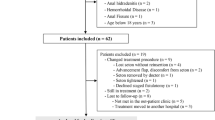Abstract
Background
Perianal abscesses and fistulae-in-ano are a common anorectal complaint causing significant distress to patients, and present a considerable treatment challenge. Principal of treatment is achieving closure of the fistula while maintaining continence. There are numerous treatment approaches with large debate about which method is “ideal.” Our aim was to assess the tolerance and efficacy of loose seton placement in the treatment for fistula-in-ano.
Methods
We performed a retrospective multicenter review of the management of anal fistulae with loose seton placement over a three-year period. All patients underwent a standardized procedure, and were rescheduled for an elective change of seton until fistula resolution. Patients’ demographics, medical history, comorbidities, overall number and time interval between seton placements, tolerance, and morbidity of the procedure were recorded.
Results
A total of 200 consecutive patients had loose seton placement. 69.5 % (n = 139) were males, and mean age was 42.6 years. The median number of setons required for each patient was 3 (range 1–8; mean 2.84). The mean interval between changes was 3.08 months (range 2–4 months). All patients had successful clearance of fistula. The procedure was well tolerated in 96 % of patients (n = 187). Only 1 % (n = 2) could not tolerate the presence of seton due to significant discomfort. Fistula recurrence rate was 6 % (n = 12).
Conclusions
Recently, newer treatment modalities have been reported with enthusiasm. However, there remains a lack of strong statistical evidence of efficacy to support their use. Overall, loose seton placement remains a well-tolerated, pragmatic low-cost solution to this common and difficult condition as evident by our study.


Similar content being viewed by others
References
Malik AI, Nelson RL (2008) Surgical management of anal fistulae: a systematic review. Colorectal Dis 10:420–430
Nelson RL (2002) Anorectal abscess fistula: what do we know. Surg Clin North Am 82:1139–1151
Zanotti C, Martinez-Puente C, Pascual I, Pascual M, Hereros D, Garcia-Olmo D (2007) An assessment of the incidence of fistula-in-ano in four countries of the European Union. Int J Colorectal Dis 22:1459–1462
Subhas G, Bhullar JS, Al-Omari A, Unawane A, Mittal VK, Pearlman R (2012) Setons in the treatment of anal fistula: review of variations in materials and techniques. Dig Surg 29:292–300
Mitalas LE, van Wijk JJ, Gosselink MP, Doornebosch P, Zimmerman DE, Schouten WR (2010) Seton drainage prior to transanal advancement flap repair: useful or not? Int J Colorectal Dis 25:1499–1502
Hermann G, Defosses L (1880) Sur la muquese de la region cloacale du rectum. Comptes End Acad Des Sci 90:1301–1302
Lockhart-Mummery JP (1929) Discussion on fistula-in-ano. Proc R Soc Med 22:1331
Gordon-Watson C, Dodd H (1935) Observation on fistula in ano in relation to perianal intramuscular glands with report of three cases. Br J Surg 22:703–709
Eisenhammer S (1956) The internal anal sphincter and the anorectal abscess. Surg Gynecol Obstet 103:501–506
Sileri P, Cadeddu F, D’Ugo S et al (2011) Surgery for fistula-in-ano in a specialist colorectal unit: a critical appraisal. BMC Gastroenterol 11:120
Parks AG, Gordon PH, Hardcastle JD (1976) A classification of fistula-in-ano. Br J Surg 63:1–12
Williams JG, Farrands PA, Williams AB et al (2007) The treatment of anal fistula: aCPGBI position statement. Colorectal Dis 9:18–50
Dudukgian H, Abcarian H (2011) Why do we have so much trouble treating anal fistula. World J Gastroenterol 17:3292–3296
George Pinedo M, Gino Caselli M, Gonzalo Urrejola L et al (2010) Modified loose-seton technique for treatment of complex anal fistula. Colorectal Dis 12:310–313
Memon AA, Murtaza G, Azami R, Zafar H, Chawla T, Laghari AA (2011) Treatment of complex fistula in ano with cable-tie seton: a prospective case series. ISRN Surgery 2011:636952
Garcia Aguillar J, Belmonte C, Wong WD, Goldberg SM, Madof RD (1996) Anal fistula surgery: factors associated with recurrence and incontinence. Dis Colon Rectum 39:723–729
Vasilevsky CA, Gordon PH (1984) The incidence of recurrent abscesses or fistula-in-ano following anorectal suppuration. Dis Colon Rectum 27:126–130
Lim CH, Shin HKS, Kang WH et al (2012) The use of a staged drainage seton for the treatment of anal fistulae or fistulous abscesses. J Korean Soc Coloproctol 28:309–314
Ritchie RD, Sackier JM, Hodde JP (2009) Incontinence rates after cutting seton treatment for anal fistula. Colorectal Dis 11:564–571
Abcarian H (2011) Anorectal infection: abscess-Fistula. Clin Colon Rectal Surg 24:14–21
Buchanan G, Owen H, Torkington J, Luniss P, Nicholls RJ, Cohen R (2004) Long-term outcome following loose-seton technique for external sphincter preservation in complex anal fistula. Br J Surg 91:476–480
Lentner A, Wienert C (1996) Long-term indwelling setons for low transsphincteric and intersphincteric anal fistulas. Experience with 108 cases. Dis Colon Rectum 39:1097–1101
Garcia Olmo D, Vasquez PA, Lopez JF (1994) Multiple seton in treatment of high peri-anal fistula. Br J Surg 81:136–137
Joy HA, Williams JG (2002) The outcome of surgery for complex anal fistulas. Colorectal Dis 4:254–261
Cirocchi R, Trastulli S, Morelli U et al (2013) The treatment of anal fistulas with biologically derived products: is innovation better than conventional surgical treatment? An update. Tech Coloproctol 17:259–273
Jurczak F, Laridon JY, Raffaitin P, Redon Y, Pousset JP (2009) Long-term follow-up of the treatment of high anal fistulas using fibrin glue. J Chir 146:1167–1174
Loungnarath R, Dietz DW, Mutch MG, Birnbaum EH, Kodner IJ, Fleshman JW (2004) Fibrin glue treatment of complex anal fistula has low success rates. Dis Colon Rectum 47:432–436
Adams T, Yang J, Kondylis PD (2008) Long-term outlook after successful fibrin glue ablation of cryptoglandular transsphincteric fistula-in-ano. Dis Colon Rectum 51:1488–1490
Conflict of interest
None.
Author information
Authors and Affiliations
Corresponding author
Rights and permissions
About this article
Cite this article
Kelly, M.E., Heneghan, H.M., McDermott, F.D. et al. The role of loose seton in the management of anal fistula: a multicenter study of 200 patients. Tech Coloproctol 18, 915–919 (2014). https://doi.org/10.1007/s10151-014-1186-0
Received:
Accepted:
Published:
Issue Date:
DOI: https://doi.org/10.1007/s10151-014-1186-0




